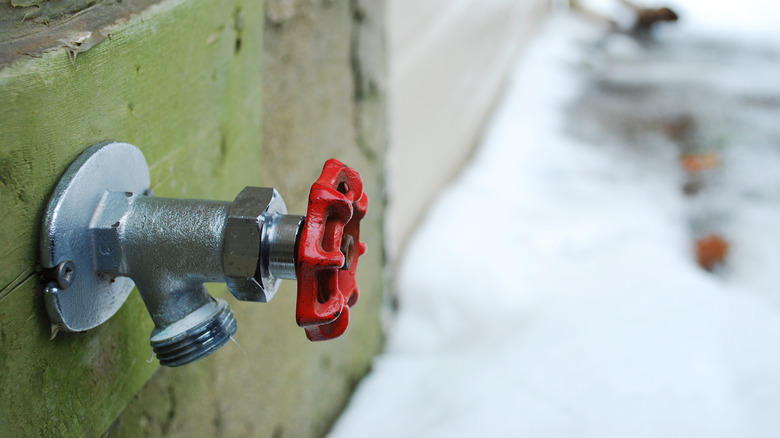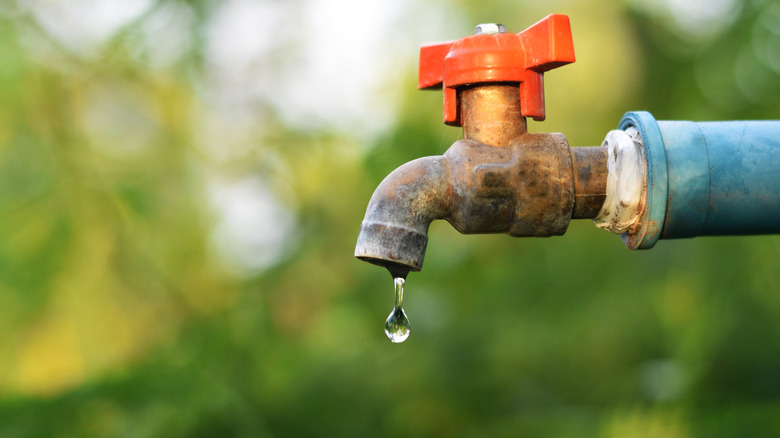The Easy DIY Faucet Cover That Can Help Prevent Frozen Pipes During Winter
Depending on where you live, the first freeze of the season may seem like no big deal — but for some, it feels like an annual catastrophe. Coping through a big freeze isn't so bad when you're stocked up on food and water and sheltered inside your home. But as you cozy up under a blanket and crack open the spine of a brand new book, it hits you: you forgot to cover the exterior faucets and the big freeze swoops in just a few hours! According to the National Weather Service, a "hard freeze" occurs when average temperatures fall below 28 degrees Fahrenheit, putting faucets and exterior pipes at serious risk for damage.
Luckily, you may not need to rush out to the store before the snowstorm hits. Chances are, you already have some items in your home that can make the perfect DIY faucet cover. All you'll need is a 2-liter bottle, some duct tape, and an insulating material such as an old T-shirt, socks, or a towel. By repurposing these cheap materials into a DIY faucet cover, you'll save money, save your pipes, and save yourself the headache of a last-minute shopping trip. Here's how to make the faucet cover and other tips to help keep your pipes from freezing.
From soda bottle to pipe protector
Start by tying a long string to the faucet handle or spigot; you'll need this later. Wrap the exposed faucet tightly with your insulating material, such as an old hand towel or a pair of socks. For extra waterproofing, wrap a plastic food storage bag or plastic grocery bags around the towel, then pull your string through any layers of insulation so that it hangs outside.
Next, cut an empty 2-liter bottle in half. Both halves can be used for this DIY faucet protector, but the top half is easier to use if you only need to cover one nozzle. Unscrew the lid from the plastic bottle half, tie a long piece of string to the faucet handle, and thread it through the opening of the bottle. Carefully slide the bottle half over the faucet, pushing all of the insulating material inside. Pull the string taught, then reattach the lid to hold the string and faucet cover in place. To use the bottom half of the bottle on another faucet, you may need to poke or melt a hole to thread the string through the bottom of the bottle. Secure this half by tying the string to a pencil or similar object, then seal it with tape. For extra security, apply tape to seal the edges of the plastic bottle where it meets the side of the house.
Other tips for protecting pipes
If you're worried that the DIY insulator may not be enough, there are other tips you can use to ensure your pipes won't freeze. For short freezes only lasting a few days, you can also consider adding a hand warmer packet inside the faucet cover. Once activated, these packets will produce heat around your faucet for up to 10 hours, giving you a little extra peace of mind on those extra cold nights. In case your pipes still freeze, hand warmers inside the pipe cover can also offer a gentle way to reheat them.
What if you don't have anything to wrap your exterior faucets? In some cases, covering the faucets may not even be the best solution. According to Environment America, if temperatures are predicted to stay below 28 degrees Fahrenheit for at least four hours, letting your faucets drip in cold weather is actually better to relieve pressure and prevent frozen water from damaging your pipes. Turn the faucet on just enough that it drips about five drops per minute — or once every 12 seconds.

